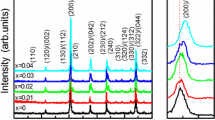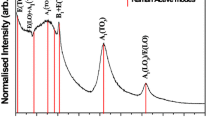Aceramic material with the composition 0.5SrTiO3—0.5Y0.1Zr0.9O2 was obtained and the characteristics of its dielectric properties and electric conductivity determined. It was found that the material consists of two phases: the cubic \( Fm\overline{3}m \) phase of yttrium-stabilized zirconium dioxide and the tetragonal I4/mcm phase of the solid solution SrTi1–x Zr x O3. Dielectric relaxation with activation energy about 1.1 eV, characteristic for titanium- containing compounds with perovskite structure, was found at temperature T > 500 K. Above ~ 700 K the electric conductivity of the experimental samples increases significantly, which could be due to an increase of the ionic conductivity. The activation energy of electric conduction was about 1.2 eV, which agrees with the value of the activation energy of ionic conduction of zirconium dioxide.




Similar content being viewed by others
References
S. K. Bandyopodhyay and A. K. Pal, “The effect of grain boundary scattering on the electron transport of aluminium films,” J. Phys. D.: Appl. Phys., 12, 953 – 960 (1979).
Q. G. Zhang, X. Zhang, B. Y. Cao, M. Fujii, et al., “Influence of grain boundary scattering on the electrical properties of platinum nanofilms,” Appl. Phys. Lett., 89, 114102-1 – 114102-3 (2006).
R. Henriquez, S. Cancino, A. Espinosa, et al., “Electron grain boundary scattering and the resistivity of nanometric metallic structures,” Phys. Rev. B, 82, 113409-1 –113409-4 (2010).
A. V. Mayadas and M. Shatzkes, “Electrical-resistivity model for polycrystalline films: the case of arbitrary reflection at external surfaces,” Phys. Rev. B, 1(4), 1382 – 1388 (1970).
J. Garcia-Barriocanal, A. Rivera-Calzada, M. Varela, et al., “Tailoring disorder and dimensionality: strategies for improved solid oxide fuel cell electrolytes,” Chem. Phys. Chem., 10, 1003 – 1011 (2009).
Yu. I. Komolikov and I. D. Kashcheev, “High-Strength ceramics based on zirconium dioxide powder,” Steklo Keram., No. 5 – 6, 194 – 198 (2002); Yu. I. Komolikov and I. D. Kashcheev, “High-Strength ceramics based on zirconium dioxide powder,” Glass Ceram., 59(5 – 6), 194 – 198 (2002).
O. N. Ivanov, R. A. Lyubushkin, Ya. V. Trusova, and E. P. Dan’- shina, “Physical and technological factors determining Y–ZrO2–Al2O3 composite nanostructured ceramic density,” Steklo Keram., No. 1, 16 – 19 (2012); O. N. Ivanov, R. A. Lyubushkin, Ya. V. Trusova, and E. P. Dan’shina, “Physical and technological factors determining Y–ZrO2–Al2O3 composite nanostructured ceramic density,” Glass Ceram., 69(1 – 2), 16 – 19 (2012).
J. Garsia-Barriocanal, A. Rivera-Calzada, M. Varela, et al., “Colossal ionic conductivity at interfaces of epitaxial ZrO2: Y2O3/SrTiO3 heterostructures,” Chem. Phys. Chem., 10, 676 – 680 (2009).
T. Pennycook and M. P. Oxley, “Seeing oxygen disorder in YSZ/SrTiO3 colossal ionic conductor heterostructures using EELS,” Eur. Phys. J. Appl. Phys., 54, 3507 – 3511 (2011).
V. M. Zainullina, V. P. Zhukov, V. M. Zhukovskii, and N. I. Medvedeva, “Electronic structure and characteristics of ionic conduction in zirconium dioxide stabilized by calcium and yttrium dopants,” Zh. Struktur. Khim., 41(1), 229 – 239 (2000).
G. A. Smolenskii, V. A. Bokov, V. A. Isupov, et al., Physics of Ferroelectric Phenomena [in Russian], Nauka, Leningrad (1985).
Z. Wu Z, M. Cao, H. Yu, et al., “The microstructure and dielectric properties of xSrZrO3–(1–x)SrTiO3 ceramics,” J. Electroceram., 21, 210 – 213 (2008).
C. Ang, Z. Yu, and L. E. Cross, “Oxygen-vacancy-related low frequency dielectric relaxation and electrical conduction in Bi: SrTiO3 ,” Phys. Rev. B, 62(1), 228 – 236 (2000).
M. Kuwabara, K. Goda, and K. Oshima, “Coexistence of normal and diffuse ferroelectric-paraelectric phase transitions in (Pb, La)TiO3 ceramics,” Phys. Rev. B., 42(16), 10012 – 10015 (1990).
O. Bidault, P. Goux, M. Kchikech, et al., “Space charge relaxation in perovskites,” Phys. Rev. B, 49, 7868 – 7873 (1994).
Z. Yu, C. Ang, P. M. Vilarinho, et al., “Dielectric properties of Bi doped SrTiO3 ceramics in the temperature range of 500 – 800 K,” J. Appl. Phys., 83, 4874 – 4877 (1998).
B. S. Kang, S. K. Choi, and C. H. Park, “Diffuse dielectric anomaly in perovskite-type ferroelectric oxides in the temperature range of 400 – 700°C,” J. Appl. Phys., 94(3), 1904 – 1911 (2003).
X. Dai, Z. Li, X. Z. Chan, and D. J. Lam, “Dielectric frequency dispersion behavior in flux grown PbTiO3 single crystals,” Ferroelectrics, 135, 39 – 48 (1992).
R. Stumpe, D. Wagner, and D. Bauerle, “Influence of bulk and interface properties on the electric transport in ABO3 perovskites,” Phys. Status Solidi. A, 75, 143 – 154 (1983).
V. G. Zavodinskii, “On the mechanism of ionic conduction in stabilized cubic zirconium dioxide,” Fiz. Tverd. Tela, 46(3), 441 – 445 (2004).
N. V. Tokii, B. I. Perekrestov, D. L. Savina, and I. A. Danilenko, “Concentration and temperature dependence of oxygen migration energy in yttrium stabilized zirconium dioxide,” Fiz. Tverd. Tela, 53(9), 1732 – 1736 (2011).
The Ministry of Education and Science of the Russian Federation provided financial support for this work under contract No. 14.594.21.0010, unique code RFMEFI59414X0010; project No. 3.308.2014/K). The instrumentation resources of the Center for the Collective Use of the Scientific Equipment “Diagnostics of the Structure and Properties of Nanomaterials” was used within the framework of the contract No. 14.594.21.0010 in the conducting research.
One of us (O. N. Ivanov) also participated in the research as a director within the framework of the implementation of the measures Organization of Scientific Research of the government task given to institutions of higher learning and scientific organizations in the sphere of scientific activity (project No. 2014/420-1).
Author information
Authors and Affiliations
Corresponding author
Additional information
Translated from Steklo i Keramika, No. 10, pp. 27 – 31, October, 2015.
Rights and permissions
About this article
Cite this article
Ivanov, O.N., Sudzhanskaya, I.V. & Lyubushkin, R.A. Dielectric Relaxation and Ionic Conductivity of a Ceramic System SrTiO3/Y0.1Zr0.9O2 . Glass Ceram 72, 376–380 (2016). https://doi.org/10.1007/s10717-016-9793-z
Published:
Issue Date:
DOI: https://doi.org/10.1007/s10717-016-9793-z




